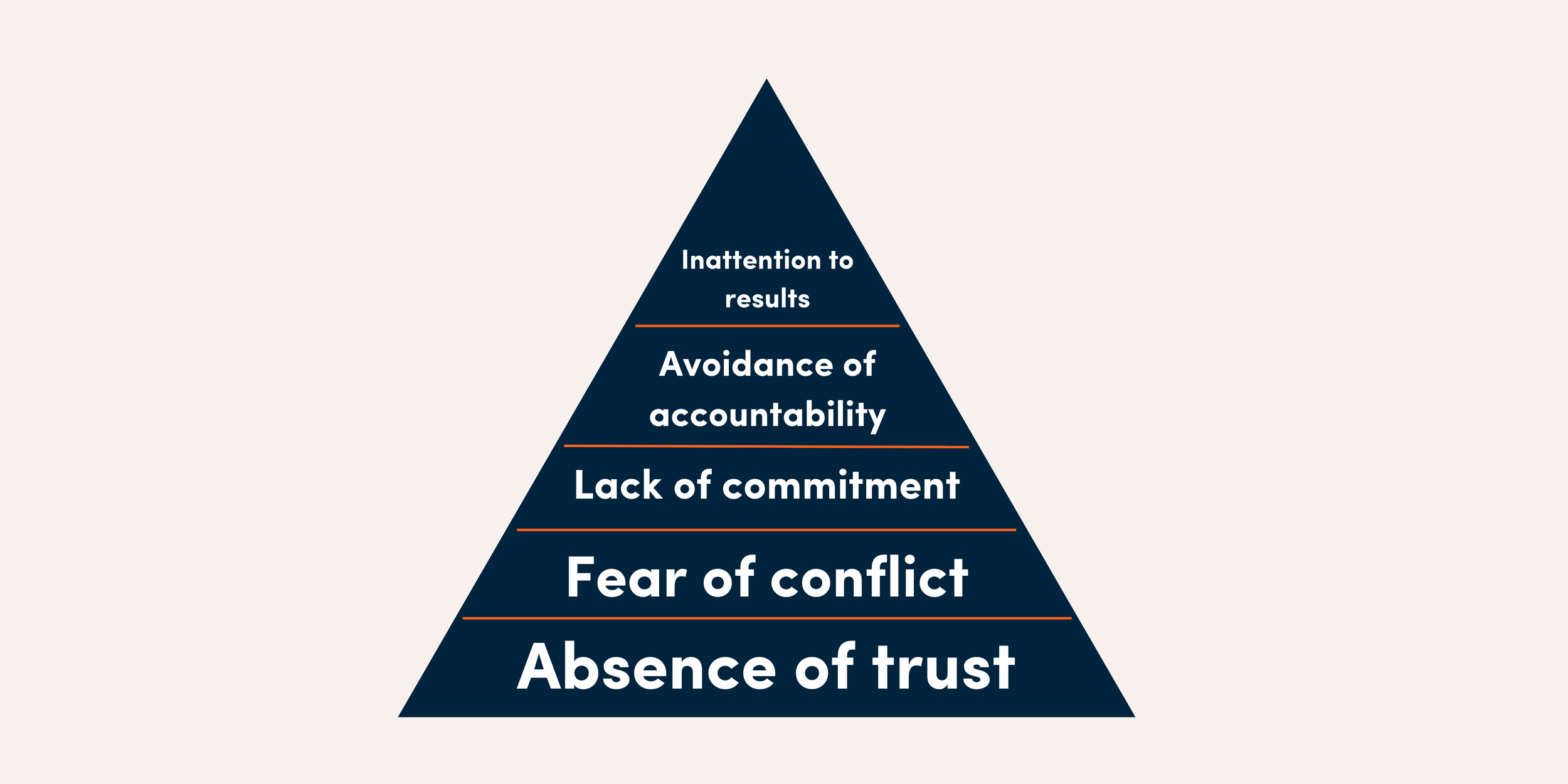The five dysfunctions of a team
A must read for every Team Leader is Patrick M Lencioni’s “The Five Dysfunctions of a Team: A Leadership Fable”.
Lencioni’s cleverly written book reveals the five dysfunctions via a compelling story, which make it much easier to digest than many other leadership books.
On top of identifying the most common reasons why teams fail, he also provides a model and actionable steps that can be used to overcome these common hurdles and build a cohesive, effective team.
While we recommend you read the book yourself in all its detail, here is a quick summary of the 5 Dysfunctions of a Team, as described in the book.
Analysing your team
Before getting into the big 5, Lencioni suggests starting with these five questions about your team:
Do your team members openly and readily disclose their opinions?
Are your team meetings compelling and productive?
Does your team come to decisions quickly and avoid getting bogged down by consensus?
Do your team members confront one another about their shortcomings?
Do your team members sacrifice their own interests for the good of the team?
If you answered “yes” to all five, then it sounds like your team is pretty functional! Good for you.
Maybe you don’t need to read the book after all…
But if you answered “no”, or made some noise resembling a maybe, you likely have some work to do.
What are the 5 dysfunctions of a team?
The 5 dysfunctions of a team are presented in a triangle, similar to Maslow’s hierarchy of needs.
In case you need a quick refresh on the rationale behind Maslow’s pyramid, it’s that the lower order needs must be met before the higher order needs.
Similarly, Lencioni argues that without building trust in your team, you can forget about building a functional team. But let’s have a closer look at each.
Credit: Patrick M Lencioni, “The 5 Dysfunctions of a Team: A Leadership Fable”
Absence of trust
This occurs when team members are reluctant to be vulnerable with one another and are unwilling to admit their mistakes, weaknesses, or need for help.
Without a certain comfort level among team members, a foundation of trust is not possible.
How to address absence of trust in a team
Here are some ideas that can help a team that lack’s trust:
Provide opportunities to build personal relationships. Trust among team members is normally developed over time.
Get to know each other better using an exercise or activity with that focus - e.g. having team members answer a small selection of self-reflection questions during a meeting.
Team effectiveness exercise - have team members select significant contributions of their peers to the group.
Fear of conflict
Teams that lack trust will not engage in honest debate about key work problems, causing situations where productivity and creativity suffer.
When team members are not willing to speak up due to conflict avoidance, inferior decisions are made.
How to address fear of conflict in a team
There are a couple of ways suggested to ensure conflict is not avoided:
“Mining” - designating a team member who “mines” for past disagreements that were buried and surfaces them
The “Thomas-Kilmann Conflict Mode” - this instrument / assessment is designed to measure a person’s beahviour in conflict situations. It enables team members to comprehend natural predisposition toward confrontation in order to make better decisions.
Lack of commitment
Without conflict, it is difficult for team members to commit to decisions, creating an environment where ambiguity prevails.
Lack of direction and commitment can make employees, particularly the best ones, unmotivated and disengaged.
How to address lack of commitment in the team
Here are a couple of simple yet powerful tools and principles suggested:
Cascading messaging - having the team go through the main points and decisions taken at the meeting and reach an agreement on what must be conveyed to employees or other stakeholders.
Contingency and worst-case scenario analysis - having a team making contingency measures ahead of time or, better yet, explaining the worst-case scenario for a difficult decision to make.
Avoidance of accountability
When teams don’t commit to a clear plan of action, even the most focused and driven people hesitate to call their peers out on actions and behaviors that may seem counterproductive to the team.
This allows for mediocrity, poor performers to slip by and the leader to become the sole source of discipline.
How to address avoidance of accountability in a team
Adherence to a few tried-and-true management tools is the key to resolving this dysfunction.
Team rewards- by redistributing incentives from individual performance and team accomplishment, the team may establish an accountability culture.
Publication of goals and standards- clarifying clearly what the team needs to achieve, who needs to deliver what, and how everyone must behave in order to succeed is an excellent method to make it simpler for team members to hold one another responsible.
Inattention to results
Team members naturally tend to put their own needs (ego, career development, recognition, etc.) ahead of the collective goals of the team when individuals aren’t held accountable.
If a team has lost sight of the need for achievement, the business ultimately suffers.
How to address inattention to results in a team
Here are some things that can help the team focus on results:
Results-based rewards - tying team members' benefits, particularly salary, to specific outcomes is an effective strategy to guarantee that they focus their attention on results.
Public declaration of results - teams that are able to openly commit to particular outcomes are more likely to operate with a strong, if not urgent, desire to attain those outcomes.
Teams flourish when they can overcome the inherent impulses that make trust, conflict, commitment, accountability, and a focus on results so difficult.
By accepting each other and working with their own and others strengths and weaknesses, teams function much more productively.
Easier said than done!

